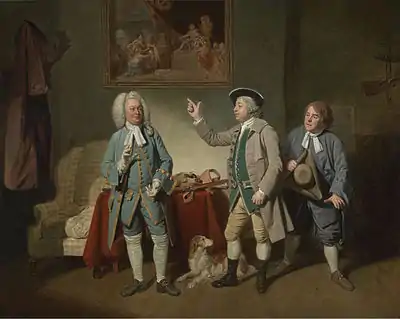Love in a Village
Love in a Village is a ballad opera in three acts that was composed and arranged by Thomas Arne. A pastiche, the work contains 42 musical numbers of which only five were newly composed works by Arne. The other music is made up of 13 pieces borrowed from Arne's earlier stage works, a new overture was by C. F. Abel, and 23 songs by other composers, including Bishop, Boyce, Geminiani, Giordani, and Galuppi, albeit with new texts. The English libretto, by Isaac Bickerstaffe, is based on Charles Johnson’s 1729 play The Village Opera. The opera premiered at the Royal Opera, Covent Garden in London on 8 December 1762.[1] One of its best known songs is the Miller of Dee.
| Love in a Village | |
|---|---|
| Ballad opera (pastiche) by Thomas Arne | |
 1767 oil painting by Johann Zoffany showing Edward Shuter as Justice Woodcock, John Beard as Hawthorn, and John Dunstall as Hodge in Act 1, Scene 2 | |
| Librettist | Isaac Bickerstaffe |
| Based on | Johnson's The Village Opera |
| Premiere | |
History
Love in a Village was received enthusiastically at its premiere and became one of Arne's more popular operas, enjoying 40 performances in its first season alone. The work's success began a vogue for pastiche opera in England that lasted well into the 19th century. The opera has subsequently been revived numerous times, both during Arne's lifetime and after. A notable revival occurred at the Lyric Hammersmith in London in 1928, using an adaptation by Alfred Reynolds. The opera was first published in 1763, but without recitative or librettos. A copy of the full score, which is partly in the composer’s hand, also survives and is in the collection of the library at the Royal College of Music. Most of the music displays a simple and lyrical nature with the exception of the music for Rosetta. Rosetta, a role written for Arne's lover Charlotte Brent, requires a gifted coloratura soprano, particularly for the aria "The traveller benighted" which has several challenging passages containing wide vocal leaps, fast runs, and trills.[1]
Roles
| Role | Voice type | Premiere Cast,[2] 8 December 1762 (Conductor: - Thomas Arne) |
|---|---|---|
| Rosetta | soprano | Charlotte Brent |
| Thomas Meadows | tenor | George Mattocks |
| Lucinde | soprano | Isabella Mattocks |
| Farmer Hawthorne | tenor | John Beard |
| Eustace | tenor | Michael Dyer |
| Margery | soprano | Cecilia Davies |
| Hodge | tenor | John Dunstall |
| Justice Woodcock | spoken role | Edward Shuter |
| Sir William Meadows | spoken role |
Synopsis
The heroine of the story, Rosetta, is fearful of her impending marriage to a man she has never met. Worried that she will be miserable, she runs away from home and acquires a position as a chambermaid in the home of Justice Woodcock. Meanwhile, the son of Sir William Meadows, Thomas, is in an equivalent situation. He also avoids his impending marriage by posing as a gardener in the Justice's household. Rosetta and Thomas meet and soon fall in love. However, both of their families are determined to make them marry their intended future spouses. Just as all seems hopeless, Sir William arrives and reveals that the young lovers have in fact been betrothed to each other the whole time.[1]
Arias
|
Act 1[3]
|
Act 2
|
Act 3
|
Sources
- John A. Parkinson: "Love in a Village", Grove Music Online ed. L. Macy (Accessed February 16, 2009), (subscription access)
- Casaglia, Gherardo (2005)."Love in a Village". L'Almanacco di Gherardo Casaglia (in Italian).
- Based on: Love in a Village (London: John Walsh, 1763).